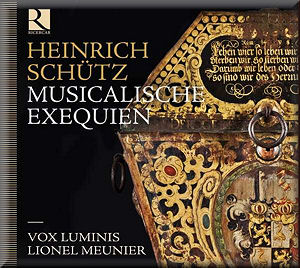 |
 |
|


alternatively
CD: MDT
AmazonUK
AmazonUS |
Heinrich SCHÜTZ
(1585-1672)
Herr, nun lässest du deinen Diener in Friede fahren
(SWV 432) [4:00]
Ich bin die Auferstehung und das Leben (SWV 464) [3:36]
Herr, nun lässest du deinen Diener in Friede fahren
(SWV 433) [3:18]
Das ist je gewißlich wahr (SWV 277) [4:43]
Samuel SCHEIDT (1587-1654)
Wir glauben all an einen Gott* [3:15]
Martin LUTHER (1483-1546)
Mit Fried und Freud ich fahr dahin [3:28]
Heinrich SCHÜTZ
Musicalische Exequien (SWV 279-281) [32:44]
 Vox Luminis/Lionel Meunier
Vox Luminis/Lionel Meunier
Bernard Foccroulle (organ)*
rec. October 2010, Église Saint-Jean l'évangeliste,
Beaufays; 1999, Abbaye Notre-Dame of Leffe (*), Belgium. DDD
 RICERCAR RIC311 [55:07]
RICERCAR RIC311 [55:07] 
|
|
|
Death plays an important role in the music of the renaissance
and baroque eras. It was a daily experience: wars and disasters
made many victims, and so did diseases which have now practically
disappeared, like the plague. Moreover, relatively few children
survived their first year. In a time in which almost everyone
believed in God it was only logical that people turned to their
faith and the Church in times of sorrow. That resulted in a
large number of compositions which are related to suffering
and death.
Most of Johann Sebastian Bach's motets were composed for funerals.
In the oeuvre of Heinrich Schütz one can also find a number
of pieces which were written at the occasion of the death of
a particular person or were suited to funerals. The most famous
of them is the main work on this disc, the Musicalische Exequien.
It was performed in February 1636 during the funeral of Herr
Heinrich Posthumus von Reuß, who had died on 3 December
of the previous year. He himself had painstakingly outlined
every detail of his funeral. He should be buried in a copper
coffin which should be adorned with 22 texts he himself had
chosen. They were partly taken from the Bible and partly extracts
from various hymns. It is often written that Herr von Reuß
himself had asked Schütz to set them to music, but the
Schütz scholar Werner Breig believes that it is more likely
that Schütz received the commission from his widow and
sons.
The Musicalische Exequien are divided into three sections.
Part 1 contains the quotations from the Bible and from hymns
which are set in the form of a German Mass - it says: Concert
in Form einer teutschen Begräbnis-Missa. The quotations
from the Bible are set as little sacred concertos, the hymns
as 6-part motets. Schütz opts not to use the chorale melodies
which were deployed by so many other German composers.
Part 2 is a sermon motet, Herr, wenn ich nur dich habe.
The text consists of the verses 25 and 26 of Psalm 73: "Lord,
if I have none other than you, so shall I ask nothing of heaven
or earth". It is scored for eight voices in two choirs.
Part 3 is a setting of the Canticum Simeonis (Nunc dimittis),
Herr, nun lässest du deinen Diener in Friede fahren
("Lord, now lettest Thou Thy servant depart in peace"). Here
Schütz has added that this text should be sung by a five-part
choir of lower voices near the organ, whereas two sopranos and
a bass should sing the text "Selig sind die Toten" (Blessed
are the dead which die in the Lord) from the back of the vault
in which Posthumus von Reuß was laid to rest.
There is no reconstruction of the whole ceremony here. That
would probably be impossible as I doubt whether it is exactly
known what it looked like. Some elements are represented. The
Exequien are preceded by Martin Luther's funeral hymn
Mit Fried und Freud ich fahr dahin which is sung unisono
by the whole ensemble. This is preceded by an organ arrangement
of the hymn Wir glauben all an einen Gott, Luther's version
of the Credo which was sung in every service in Lutheran Germany.
The disc begins with four funeral motets Schütz composed
for various people he knew personally. In 1630 Johann Hermann
Schein died, who was a personal friend of his, and Thomaskantor
in Leipzig. Schütz composed the motet Das ist je gewißlich
wahr (SWV 277), with a moving tribute on the title page
to this "man of most excellent genius and virtue". Another motet,
Ich bin die Auferstehung und das Leben (SWV 464), was
written for the funeral of Anton Colander, court organist in
Dresden and a pupil of Schütz.
A favourite text for funerals was the Canticum Simeonis,
known under the Latin title of Nunc dimittis, in Germany
mostly with the text Herr, nun lässest du deinen Diener
in Friede fahren. It is the closing section of the Musicalische
Exequien, but Schütz also set this text twice in 1656
for the funeral of Georg I, the Elector of Saxony, who had been
Schütz's employer for more than forty years. The first
setting was to be sung before, the second after the sermon.
Both are for six voces and basso continuo.
I am very impressed by these performances of Vox Luminis. There
is certainly no lack of recordings of the Musicalische Exequien,
but this one lands at the top of my list, alongside the performance
of the Collegium Vocale under Philippe Herreweghe (Harmonia
mundi). The singing, both solo and ensemble, is of great beauty.
More importantly, the delivery is outstanding, which is essential
in a performance of any work by Schütz who paid so much
attention to the text that he was nicknamed Musicus poeticus.
Moreover, this recording has the solemn atmosphere this work
demands. The other motets are given equally impressive interpretations.
Every reason to label this disc Record of the Month and
add it to my list of potential recordings of the year.
Johan van Veen
http://www.musica-dei-donum.org
https://twitter.com/johanvanveen
|
|

